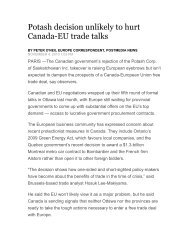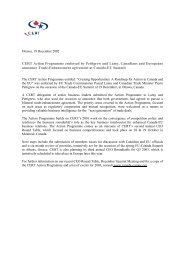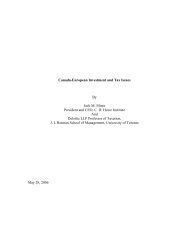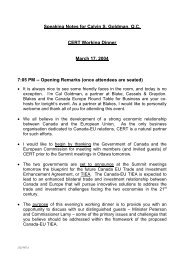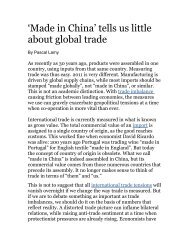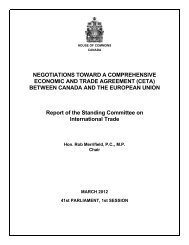Kellie Calnan - CERT - Canada Europe Round Table for Business
Kellie Calnan - CERT - Canada Europe Round Table for Business
Kellie Calnan - CERT - Canada Europe Round Table for Business
- No tags were found...
Create successful ePaper yourself
Turn your PDF publications into a flip-book with our unique Google optimized e-Paper software.
The <strong>Canada</strong> <strong>Europe</strong> <strong>Round</strong> <strong>Table</strong> <strong>for</strong> <strong>Business</strong>: <strong>Canada</strong>-<strong>Europe</strong>an Union <strong>Business</strong>Prospective on Regulatory Cooperation, Mutual Recognition and CompetitionA Reply to Gazette Notice-“Consultations on enhancing <strong>Canada</strong>- <strong>Europe</strong>an Union trade and economic relations multilaterally and through anew bilateral trade and investment initiative”Submitted on 13 June 2003 by:<strong>Canada</strong> <strong>Europe</strong> <strong>Round</strong> <strong>Table</strong> <strong>for</strong> <strong>Business</strong> (<strong>CERT</strong>)Rue Froissart, 57B-1040 Brussels, Belgiumwww.canada-europe.org
IntroductionOn behalf of its members, the <strong>Canada</strong> <strong>Europe</strong> <strong>Round</strong> <strong>Table</strong> <strong>for</strong> <strong>Business</strong> (<strong>CERT</strong>) 1 is pleased to providecomments to the Department of Foreign Affairs and International Trade (DFAIT) concerning its call <strong>for</strong> Canadianviews on deepening its economic relationship with the <strong>Europe</strong>an Union (EU). In particular, we are supportive ofthe comments delivered by the Canadian Chamber of Commerce, who is an active member of <strong>CERT</strong> andCanadian Chair of our Doha Development Agenda working group, in its submission to DFAIT on Enhancing<strong>Canada</strong>-<strong>Europe</strong>an Union Trade and Economic Relations.<strong>Canada</strong>-EU Trade and Investment Enhancement Agreement (CEUTIEA)Following the delivery of <strong>CERT</strong> Action Programme “Creating Opportunities: A roadmap <strong>for</strong> action in <strong>Canada</strong> andthe EU” on the occasion of the 19 December 2002 Summit meeting in Ottawa, <strong>CERT</strong> has commenced policywork in a series of horizontal working groups focused on developing business recommendations <strong>for</strong> the<strong>for</strong>mation of the CEUTIEA.<strong>CERT</strong> working groups are now active on Regulatory Cooperation & Mutual Recognition, Competition, Research& Development and the Doha Development Agenda (DDA). The Regulatory Cooperation & Mutual Recognitionand Competition working groups have drafted discussion papers that were submitted to Minister Pettigrew andCommissioner Lamy on the occasion of the May 2003 <strong>Canada</strong>- EU Summit in Athens, Greece. Thesesubmissions, which can be found in Annex I and II to this paper, are in keeping with <strong>CERT</strong>’s mandate to assistthe <strong>for</strong>mation of public policy so that this same policy maximizes the scope and ability of the market to allowsprogressive business activity to flourish. The discussion papers <strong>for</strong> these two working groups will be updatedshortly. We also plan to have first drafts of discussion papers <strong>for</strong> our Research & Development and DDA workinggroups prepared soon.Regulatory Cooperation and Mutual RecognitionAs discussed in the 2003 Discussion Paper on Regulatory Cooperation and Mutual Recognition, the mostrestrictive obstacles to trade and investment are those related to different regulatory requirements on both sidesof the Atlantic. In response to this issue, <strong>CERT</strong> has developed a number of recommendations to intensifyregulatory dialogue between the EU and <strong>Canada</strong>, and to address regulatory issues affecting specific sectors thatare referred to in Annex I. <strong>CERT</strong> stresses the importance of the implementation of the World Trade Organisation(WTO) Agreements on Technical Barriers to Trade (TBT) and on Sanitary and Phytosanitary Measures (SPS). Inaddition, <strong>CERT</strong> feels that an improved <strong>Canada</strong>-EU regulatory co-operation should respect national treatmentand most favoured nation and not result in discriminatory practices amongst trade partners.Furthermore, <strong>CERT</strong> recommends that any enhanced regulatory dialogue between the EU and <strong>Canada</strong> shouldseek a maximum degree of coherence with the co-operation that both, the EU and <strong>Canada</strong>, have developed withthe US in this area. Cooperation and in<strong>for</strong>mation sharing should occur at an early stage of regulatory <strong>for</strong>mation(this could include in<strong>for</strong>mation exchange on the Canadian SMART regulation initiative and the <strong>Europe</strong>an BetterRegulation initiative). In addition, risk assessment should be based on sound science and not be misleading.In Annex III we have also included the position of new <strong>CERT</strong> member the TSX Group with regards to securitiesregulation. This position will be incorporated into the second draft of the regulatory cooperation working paper.CompetitionThe 2003 Discussion Paper on Competition notes that government policies affecting bilateral trade should avoidany unnecessary barriers to trade being the least restrictive possible. <strong>CERT</strong> believes that in order to facilitate1 The <strong>Canada</strong> <strong>Europe</strong> <strong>Round</strong> <strong>Table</strong> <strong>for</strong> <strong>Business</strong> (<strong>CERT</strong>) is a permanent <strong>for</strong>um <strong>for</strong> dialogue on major trade and investment matters amongsenior business leaders, Canadian and <strong>Europe</strong>an, and among business leaders and governments. Its membership comprises companiesand business associations in the <strong>Europe</strong>an Union (EU) and <strong>Canada</strong>.
ilateral trade, competition laws should be transparent and non-discriminatory, and that regulatory barriers in thecompetition field that impede investment are as serious as other impediments such as tariff barriers.Regulatory barriers in the competition context include not only the existence of regulation, but also the degree ofconvergence of regulation between trading partners. An example of this is more onerous or different reportingobligations, longer pre-merger waiting periods, and en<strong>for</strong>cement techniques that raise business concerns andlead to a chilling effect on investment. In addition, business has concerns about differing regulatory filingrequirements and filing thresholds among jurisdictions.<strong>CERT</strong> feels that they are considerable gains to be made from EU and <strong>Canada</strong> working more closely on thedevelopment and alignment of their regulatory structures. As a result, our Competition working group hasfocused on the following two areas: 1) reducing impediments to bilateral trade and investment in the context ofcompetition laws and bilateral cooperation between Canadian and EU competition authorities; 2) and providingbusiness views on the competition element of the Doha Declaration and the mandate of the Working Group onthe Interaction between trade and Competition.Research & DevelopmentThe overall goal of this working group is to promote a higher rate of transatlantic participation in R&D initiatives.In turn, <strong>CERT</strong> supports the simpler and more uni<strong>for</strong>m application rules, streamlined processes and harmonizedtime frames <strong>for</strong> joint participation in EU and Canadian research programmes. Sharing of research funds,especially in highly specialized areas where one or other of the trading partners lacks the facilities or expertise toconduct the research on domestic soil, should also a priority.Doha Development Agenda (DDA)<strong>CERT</strong>’s DDA working group is in the process of aligning positions of common interest between <strong>Canada</strong> and theEU. Following the Cancun Ministerial, the group is planning to create an inventory of areas that could becomeWTO-plus initiatives through incorporation into the CEUTIEA, where relevant.ConclusionFor our part, <strong>CERT</strong> will continue to implement its Action Programme which was submitted at the December 2002<strong>Canada</strong>-EU Summit in Ottawa. This will include further recommendations <strong>for</strong> the development of the CEUTIEAfrom <strong>CERT</strong> working groups. Through regular meetings we plan to continue the dialogue on bilateral trade andinvestment issues between <strong>CERT</strong> representatives and government officials through the announcement of thepolitical framework <strong>for</strong> the CEUTIEA in December 2003, and beyond, to negotiations commencing in 2004.This year will also see our third annual CEO <strong>Round</strong> <strong>Table</strong> in Toronto this November (a date will be announcedshortly). The 2003 event will focus on the interplay between trade facilitation, in<strong>for</strong>mation and security, with thekey outcomes to be delivered to government on the occasion of the December <strong>Canada</strong>-EU Summit in Ottawa.In conclusion, the Canadian government has <strong>CERT</strong>’s full support <strong>for</strong> your ef<strong>for</strong>ts to develop a wide-ranging<strong>Canada</strong>-EU Trade and Investment Enhancement Agreement (CEUTIEA). I would like to think that with the rapidconclusion of such an agreement, we can open a new chapter in EU-<strong>Canada</strong> business relations. At the sametime, and more broadly, <strong>Canada</strong> and the EU may help to establish a model <strong>for</strong> future bilateral trade agreements.We look <strong>for</strong>ward to working closely with your officials to find innovative ways in which to expand bilateralbusiness opportunities.Signed by,Boris RousseffExecutive Director
Annex IRegulatory Co-operation and Mutual Recognition Working Group2003 Discussion Paper - DraftIntroduction.In the relationship between <strong>Canada</strong> and the EU, the most important obstacles to trade arethose referred to different regulatory requirements between both sides of the Atlantic. Withthe aim of strengthening trade and investment between the transatlantic business community,the <strong>Canada</strong> <strong>Round</strong> <strong>Table</strong> <strong>for</strong> <strong>Business</strong> (<strong>CERT</strong>) has developed a number of recommendationsto intensify regulatory dialogue between the EU and <strong>Canada</strong>, and to address regulatoryissues affecting specific sectors. These recommendations are referred to:• Framework recommendations that take account of the environment in which the EU and<strong>Canada</strong> operate.• Priority areas <strong>for</strong> policy based regulatory co-operation.• Priority areas <strong>for</strong> sector- based regulatory co-operation.Internationalcoherence-WTO/ use ofinternationalstandardsFramework ConditionsFirst of all, a strengthened regulatory co-operation should not result in new barriers to globaltrade but in a further support of international schemes already in place. There<strong>for</strong>e we stressthe importance of the implementation of the World Trade Organisation (WTO) Agreements onTechnical Barriers to Trade (TBT) and on Sanitary and Phytosanitary Measures (SPS). Also,according to the WTO principles, an improved <strong>Canada</strong>-EU regulatory co-operation shouldrespect WTO principles of national treatment and most favoured nation and not result indiscriminatory practices towards other trade partners.Also both governments should promote the use of voluntary international standards instead ofdeveloping national mandatory requirements to develop competitiveness at a global level.Coherencebetweenregulatoryschemes withUS.An enhanced regulatory dialogue between the EU and <strong>Canada</strong> should seek a maximumdegree of coherence with the co-operation that both, the EU and <strong>Canada</strong>, have developedwith the US in this area. On the one hand regulatory co-operation is already quite welldeveloped between the EU and the US, which in April 2002 approved a set of "Guidelines onRegulatory Co-operation and Transparency". On the other hand, the NAFTA agreementbetween <strong>Canada</strong>, the United States and Mexico includes a chapter on regulatory cooperationthat also calls <strong>for</strong> enhanced in<strong>for</strong>mation and transparency in the regulatory activitiesin each of the countries. The development of regulatory co-operation between <strong>Canada</strong> andthe EU could build on these experiences. The establishment of a co-operation frameworkalong the same lines will not only provide <strong>for</strong> more consistent trade access among thedifferent partners but also reduce the complexity in their implementation since the officialsfrom both governments will work following similar schemes.CanadianprovincesRegulatory co-operation must comprise all levels of government. This is especially importantin the case of Canadian provinces that have the regulatory power in some sectors. There<strong>for</strong>egovernments from the Canadian provinces should directly participate in any co-operativeactivity with the <strong>Europe</strong>an Commission in those areas where they have the regulatory power,without needing the intervention of the federal level. The objective is that those actors that willimplement any decision will also participate in the decision making process.
Priority areas <strong>for</strong> policy based regulatory co-operationThere are three basic areas <strong>for</strong> policy based regulatory co-operation where the Canadiangovernment and the <strong>Europe</strong>an Commission should put especial emphasis: the avoidance ofdiverging regulations at an early stage of the regulatory process, a greater transparency andinvolvement of stakeholders and finally the development of common approaches to theassessment of risk in relation to environment or health/safety of consumers.EnhancedtransparencybetweenadministrationsDifferent regulatory outcomes should be avoided from the beginning. There<strong>for</strong>e it isnecessary that EU and Canadian authorities define mechanisms by which they in<strong>for</strong>m eachother at an early stage when <strong>for</strong>mulating legislation or regulatory decisions 2 . Thesemechanisms should include regularly scheduled exchanges, contacts and data sharingbetween EU and Canadian officials. The aim is to increase the level of predictability in theregulatory process and to open windows of opportunity <strong>for</strong> greater co-operation.In order to maximize the effectiveness of this recommendation, this exchange of in<strong>for</strong>mationat an early stage should be initiated in areas where there is a clear need to work together andwhere a basis <strong>for</strong> co-operation exists. Thus, and as a preliminary step, we call <strong>for</strong> aprioritization of sectors where an enhanced co-operation should be developed in the firstplace. Currently, the chemical sector represents a clear case <strong>for</strong> it.A right step into the good direction would also be to keep in<strong>for</strong>med both parts of all the newactions and regulatory changes undertaken under the Smart Regulation initiative in theCanadian case and of those changes introduced under the framework of the differentcommunications on "Better Regulation" issued by the <strong>Europe</strong>an Commission.Involvement ofstakeholdersA higher involvement of stakeholders, both national and <strong>for</strong>eign ones, is essential to improvethe quality of new regulations and prevent the adoption of requirements that may result innew trade barriers between the EU and <strong>Canada</strong>. Interested parties should be in<strong>for</strong>med of allthe regulatory initiatives that may have a significant impact on transatlantic trade and begiven the opportunity to comment in a meaningful way on those draft regulations. Thus, andin parallel to the current Commission activities on this area, the Canadian administration andthe <strong>Europe</strong>an Commission should develop common "minimum standards of consultation" tobe applied on both sides of the Atlantic. These standards should also include in<strong>for</strong>mationtransparency on any meeting between <strong>Canada</strong> and EU regulatory authorities on specificpolicy issues and the conclusions of such meetings.RiskassessmentThe area of risk assessment and precautionary measures to prevent harm to the environmentor health/safety of consumers constitutes one of the main sources of divergence in regulatoryoutcomes. Since the objective <strong>for</strong> <strong>Canada</strong> and the EU is the same, to protect public healthand environment, there is a case <strong>for</strong> developing a common approach in this area. Thiscommon approach should be guided by a series of core principles: First, any decision mustbe based on sound science and not misleading; <strong>for</strong> instance in the case of environment,authorities should use science based life-cycle methodology. If government choose to awardan environmental designation that is based on a single criterion, life-cycle impacts should beconsidered to ensure that the granting of that designation has an overall positive impact onthe environment. Second, improve the communication of in<strong>for</strong>mation about risk betweenexperts, policy-makers and legislators from both sides of the Atlantic. This will not only lead toa better understanding of each other's approach to risk but also to a better communication ofrisk assessment results to the public opinion. A bad management of risk can have a verynegative impact on trade, investment and innovation.2 Although, the WTO TBT Agreement Code of Good Practice <strong>for</strong> Voluntary Standards provides also provisions on transparency, it isessential to develop the habit of co-operation and regular contacts between officials in order to effectively implement any early warningmechanism and this must be enhanced at a bilateral level.
Specific Regulatory Issues<strong>CERT</strong> members are most concerned with how <strong>Canada</strong> and the EU’s regulatory systemsaffect trade between both jurisdictions in the following industry sectors:• Aluminum products• Chemical products• Engineering services• Forest products• Pharmaceutical productsPrimarily these concerns focus on regulations that have the effect of non-tariff barriers bycreating technical regulations or requirements that result in discriminatory treatment ofimported <strong>for</strong>eign goods versus domestically produced goods. Examples of such measurescan include customs procedures, procurement requirements, environmental policies,differentiated tax rates, discriminatory environmental labelling requirements, and a variety oflicensing and documentation requirements that target only imported goods.The objective <strong>for</strong> <strong>CERT</strong> members in this area is to have <strong>Canada</strong> and the EU give priority toremoving any already existing NTBs, and/or to prevent the introduction of any new NTBs.Specific sector areas that require immediate action include:AluminiumProducts• Aluminum products –Society needs to be concerned with the environment and solutions other than nondiscriminatingpolicy instruments must be applied to improve production anddistribution of goods to the market place. Production processes and consumerproduct standards will be thedetermining factor to environmental improvements in the application of commonsense and scientific assessments. Free market access and consumer choices basedon in<strong>for</strong>mation and preference shall dictate trade-related environmental policyinstruments.Alcan (and the Aluminium industry) understand and accept that environmentalstrategies be co-ordinated at international, as well as national levels in theharmonisation of environmental standards, unilateral trade measures and onproduction and process methods. Most importantly, the extension of the debateshould include the business community and give serious consideration to the use ofscience-based approaches in risk assessment and in the management of resourcesand products.In order to create level playing-field market conditions, equitable treatment will besought as relevant at the EU-level by levelling-off of sources of competitiveimbalances arising from EU internal policies such as energy market liberalisation,energy taxation, etc., an internationally by ensuring equal commitments by thealuminium-producing countries under the international Conventions on ClimateChange.ChemicalProducts• Chemicals products –In the area of chemical products there is growing concern that the evolving EUchemicals policy could cause difficulties <strong>for</strong> a number of industries. Under the “Reachprinciple”, industries producing and selling products containing chemicals in <strong>Europe</strong>will be under an obligation to prove that the chemicals are not toxic. Details of thepolicy are yet to be spelled out, including what the implications will be <strong>for</strong> exporters.In fact, the <strong>Europe</strong>an Commission’s enterprise and environment directoratescurrently have competing positions <strong>for</strong> the design of the policy being proposed. Thelatest proposal shows the enterprise directorate proposing to activate the
authorisation procedure only <strong>for</strong> chemicals classified as persistent organic pollutantsor as carcinogenic, mutagenic and reprotoxic; while the environment directorate andEU environment ministers want to add persistent and bioaccumulative chemicals(PBTs and vPvBs).EngineeringServices• Engineering services –The main issue in the area of engineering services <strong>for</strong> companies is the mutualrecognition of professional qualifications between <strong>Canada</strong> and the EU. Thecapability to work on both sides of the Atlantic is of great value, especially in view ofthe upcoming EU expansion to include new members.Of specific interest within this sector is that of product alignment with <strong>Europe</strong>anstandards. For instance, when a <strong>CERT</strong> member subsidiary providing fire protectionsystems tries to sell in the Eurozone, they encounter country barriers along withstandard barriers that differ from country to country. They need approvals and evenwhen these are obtained, in many cases, there is an additional requirement <strong>for</strong> theproduct to be made in the Eurozone. Actually, in order to bid, one must have a<strong>Europe</strong>an legal entity. And, whereas this is not a problem <strong>for</strong> many Canadian andAmerican companies, in general, there are subtle nuances in the “Request <strong>for</strong>Qualification” to exclude U.S. and Canadian companies from the Bid process. Forexample, many bids require that the bidder must have done similar work previously in<strong>Europe</strong> from a specific <strong>Europe</strong>an subsidiary. This means disqualification in mostcases.Forest Products• Forest products –Based on the philosophy that trade and environment policies should be and can bemutually supportive, the Canadian <strong>for</strong>est products industry is concerned that theintegrity of the rules-based world trading system is at risk if jurisdictions are permittedto use pseudo-environmental measures (e.g. environmental labelling, <strong>for</strong>estcertification and other environmental standards) as a means of imposing unjustifiednon-tariff barriers to trade. Despite being a world leader in sustainable <strong>for</strong>estmanagement practices and environmental stewardship; Canadian <strong>for</strong>est productsregularly face discriminatory <strong>for</strong>eign environmental labelling, <strong>for</strong>est certification andother environmental standards. With respect to the environment in particular,discrimination can occur as the result of differences between countries and theirrespective natural resource endowments and domestic environmental protectionneeds. Such differences, when they exist, must be addressed in order to avoid anydiscriminatory trade measures.The industry emphasizes that it strongly supports environmental standards (e.g.environmental labels and <strong>for</strong>est certification) as long as they are developed and usedin a fully transparent, non-discriminatory fashion and according to proper andsufficient scientific evidence.Some of the specific regulatory issues that are currently restricting or threateningCanadian exports in the <strong>for</strong>est products sector that would benefit from greaterregulatory cooperation and mutual recognition between <strong>Canada</strong> and the EU include:• Plant health regulations (e.g. Pinewood Nematode case at the EU level);• Environmental labeling (e.g. proposed discriminatory requirements in theNetherlands <strong>for</strong> sustainable wood products);• Green procurement (e.g. proposed discriminatory requirements in the UnitedKingdom <strong>for</strong> <strong>for</strong>est products);• Proposed EU chemicals policy (see section on chemical products above), and;• Codes and standards being revised <strong>for</strong> wood products as construction materialsat the EU level that discriminate against Canadian products.
Pharmaceuticalproducts.• Pharmaceutical products –Currently the Commission is drafting a proposal <strong>for</strong> a regulation to develop paediatricindications of medicinal products in <strong>Europe</strong>. Whatever the outcome of this proposalis, Canadian and EU authorities should start to looking at ways of ensuring that thosepaediatric indications that have been approved on one side of the Atlantic will beautomatically approved on the other.We understand that it is necessary to build confidence between Canadian and<strong>Europe</strong>an agencies and we welcome initiatives such as the existing Visiting ExpertProgramme through which the EMEA receives experts from the <strong>Canada</strong> authorities.However we highly recommend that exchanges between the Canadian healthauthorities and the EMEA are strengthened and done on a regular basis.2.1 Recommendations on Sectoral PrioritiesAll Canadian and EU government policy affecting bilateral trade in the a<strong>for</strong>ementionedsectors and the respective issues identified within each of those sectors should:• Be addressed on a priority basis ahead of all other sectoral issues.• Be addressed within the context of the a<strong>for</strong>ementioned recommendations on policyarea priorities.• Ensure all new standards and regulations implemented within the sectors identifiedare non-discriminatory and as cost-efficient as possible in relation to <strong>for</strong>eign versusdomestic goods and services.• Ensure that all already existing standards and regulations within the sectors identifiedare non-discriminatory and as cost-efficient as possible in relation to <strong>for</strong>eign versusdomestic goods and services.• Be addressed to ensure free market competition and eliminate any and allprotectionist measures in the marketplace against one party’s goods and servicesversus the other’s.• Be addressed to ensure the alignment of standards and requirements betweenparties in areas such as environment and the issue of climate change in view ofrecent developments and the ratification of the Kyoto protocol. (e.g. SNC-Lavalin,has developed DEFI, a proprietary software <strong>for</strong> monitoring and reducing fugitivevolatile organic emissions. Such state of the art pollution prevention technologiescould lead to “niche” services from <strong>Canada</strong>, addressing the <strong>Europe</strong>an regulatoryrequirements. The same could be said <strong>for</strong> Clean Development Mechanisms andeventually possible International Emissions Trading in relation to climate change.ConclusionTo further promote and strengthen trade and investment between the transatlantic businesscommunity, especially in the context of avoiding non-tariff barriers, <strong>CERT</strong> urges <strong>Canada</strong> andthe <strong>Europe</strong>an Union to negotiate an agreement on regulatory cooperation that incorporatesall of the recommendations in this discussion paper.
Annex IICompetition Working Group2003 Discussion Paper – Draft1 Introduction1.1 The main priority of <strong>CERT</strong> is to act in such a way that all Canadian and EUgovernment policies affecting bilateral trade should be the least restrictive possible,avoiding unnecessary barriers to trade 2 .1.2 The <strong>Canada</strong> <strong>Europe</strong> <strong>Round</strong>table <strong>for</strong> <strong>Business</strong> (<strong>CERT</strong>), whose goal is to reduceobstructions to business flow and enhance trade, points out that there are considerablegains to be made from <strong>Europe</strong> and <strong>Canada</strong> working more closely on the developmentand alignment of their regulatory structures.1.3 As a consequence, the <strong>Europe</strong>an Commission’s report on EU governance as well asthe Smart Regulation initiative launched by the Canadian government which aims atcreating greater regulatory coherence have been particularly well greeted by <strong>CERT</strong>.1.4 Like other regulation, competition laws and policies can impede trade and investment.1.5 In order to facilitate bilateral trade, competition laws should be transparent and nondiscriminatory,and regulatory barriers in the competition filed that impede investmentare as serious as other impediments such as tariff barriers.1.6 Regulatory barriers in the competition context include not only the existence ofregulation, but also the degree of convergence of regulation between trading partners.For example, more onerous or different reporting obligations, longer pre-mergerwaiting periods, and en<strong>for</strong>cement techniques that raise business concerns and lead toa chilling effect on investment.1.7 In addition, business has concerns about differing regulatory filing requirements andfiling thresholds among jurisdictions.1.8 The special contribution that <strong>CERT</strong> can make is to help the Canadian and <strong>Europe</strong>anCommunity develop rules that maximize the scope and ability of business to workproductively to create wealth and employment, while maintaining appropriate individualand business freedoms.1.9 In that spirit, <strong>CERT</strong> has identified two particular areas in which we welcome theopportunity to engage in a dialogue aimed at developing initiatives to reduce barriers totrade and investment between <strong>Canada</strong> and <strong>Europe</strong>:1.9.1 Provide input regarding possible steps to reduce impediments to bilateraltrade and investment in the context of competition laws in <strong>Canada</strong> and<strong>Europe</strong> and bilateral cooperation between Canadian and EU competitionauthorities; and2 In terms of tariff issues as well as in terms of non-tariff barriers.
1.9.2 Provide input regarding business views on the competition elements of theDoha declaration and the mandate of the Working Group on the Interactionbetween Trade and Competition.2 Steps to Reduce Barriers to Trade and Investment2.1 <strong>Business</strong> representatives are concerned about safeguards <strong>for</strong> the protection ofconfidential in<strong>for</strong>mation that is exchanged between competition authorities. This is aninternational issue and one where <strong>Canada</strong> and the EU can set a new standard incooperation that addresses the concerns of business. Further, business would benefitfrom greater convergence in both procedural and substantive aspects of <strong>Canada</strong> and<strong>Europe</strong>’s respective competition laws to facilitate ease and efficiency of investmentinitiatives.2.2 In particular, the existing cooperation agreement between <strong>Canada</strong> and the EU couldbe strengthened to enhance the transparency and fairness of the cooperation process,and strengthen and clarifying the safeguards <strong>for</strong> confidential in<strong>for</strong>mation.2.3 In 1999 an Agreement was adopted between the <strong>Europe</strong>an Communities and theGovernment of <strong>Canada</strong> regarding the application of their competition laws 1 .2.4 This Agreement has two main purposes: on the one hand, promote cooperation andcoordination between competition Authorities of the <strong>Europe</strong>an Union and <strong>Canada</strong>; onthe other hand, lessen the possibility or impact of differences between the Parties inthe application of their competition laws.3 Three years after the adoption of the Agreement and in order to prepare the <strong>CERT</strong> meetingin connection with a EU-<strong>Canada</strong> Summit, it is necessary to check if it has fulfilled the roles ithad been attributed and to identify the ways and means to improve this regulatory frameworkin the interest of the undertakings.3 Regulatory co-operation3.1 Regulatory cooperation has been an achievement <strong>for</strong> both the EU and <strong>Canada</strong>regarding the application of their competition laws. However, improvements are stillpossible.Effectiveness ofthe bilateralAgreement3.2 <strong>CERT</strong> is particularly pleased about the adoption of the 1999 Agreement and canconclude to the effectiveness of this Agreement.3.3 Indeed, the Agreement facilitates the running of competition procedures that concernboth the <strong>Europe</strong>an and Canadian markets. This achievement has been possible thanksto the coordination between Commission officials and their Canadian counterparts.These officials remained in close and mutually beneficial contact all along theprocedure by sharing in<strong>for</strong>mation and by discussing and developing consistentanalysis of the substantive issues.3.4 Through the verifications carried out be<strong>for</strong>ehand (i.e. notification and consultations,semi-annual meetings of the competition Authorities) and the measures coming after amerger (e.g. coordination of en<strong>for</strong>cement activities), a real bilateral practice has beendeveloped as regards the application of EC and <strong>Canada</strong>’s competition laws.1 OJ L. 175/50, July 10th 1999.
3.5 Thus, the cooperation is of mutual benefit to both sides in terms of betterunderstanding of each other’s competition policy regimes. This is the reason why<strong>CERT</strong> would like to go further in this direction.Perspective ofevolution3.6 Regarding the encouraging results linked to the Agreement, <strong>CERT</strong> wishes to reach ahigher convergence of competition rules and procedures, especially concerning verticaland horizontal agreements, mergers and concentrations. Such a convergence of rulesand procedures would facilitate the tasks of EU and Canadian undertakings when theyhave to deal with antitrust authorities. This may imply improving the Agreement.3.7 For instance, it may be appropriate to initiate an assessment of their respectivelegislations concerning exemption regulations. An assessment of notification rules(thresholds, timing of notification, market definition) <strong>for</strong> mergers would be valuable.3.8 Thus, to improve the cooperation between the EU and <strong>Canada</strong>, <strong>CERT</strong> proposes asystematic consultation with businesses on these matters.4 Action within a multilateral framework4.1 In light of the ongoing negotiations of the Doha <strong>Round</strong>, the majority of the bilateraltrade and tariff issues will be dealt with from a multilateral perspective.4.2 <strong>CERT</strong> does fully support the objectives of the Doha <strong>Round</strong>. It estimates that the<strong>Europe</strong>an Union and <strong>Canada</strong>, working together, should have a leading role within amultilateral framework such as the WTO. Indeed, it strongly believes in the need toeliminate any obstacle to trade and investment.4.3 The “core principles” identified in the Doha declaration that set out the mandate of theWorking Party on the Interaction Between Trade and Competition – transparency, nondiscriminationand procedural fairness – are fundamental and they should be reflectedin trading partners’ competition laws.4.4 <strong>CERT</strong> strongly supports the view that competition laws should not discriminate on thebasis of nationality, and that non-discrimination should be considered a core principleof all competition laws. The principle of national treatment should apply to competitionlaws, i.e., the principle that a government should treat the goods, services and personsof other nationalities no less favorably than it treats its own.4.5 Due process and transparency are also important core principles to be respected andapplied in the design, implementation and en<strong>for</strong>cement of competition laws at thenational level and with respect to any multi-jurisdictional en<strong>for</strong>cement cooperation.Both principles are essential because they provide stakeholders – the public,consumers and competitors – some assurance that the system will produce consistentand rational results and generate confidence in the system of competition lawen<strong>for</strong>cement.4.6 While the future direction of any development of competition norms in a multilateralagreement within the WTO remains to be determined at the Cancun round ofnegotiations this fall, <strong>CERT</strong> would like to see enhanced consultation with businesspeople by governments participating in the international convergence discussion toallow them to understand the commercial costs of inconsistent rules in this area.4.7 <strong>CERT</strong> could provide to both partners the business perspective on competition policyissues currently being studied by the WTO working group on the interaction betweentrade and competition policy.
4.8 Indeed, guaranteeing a level playing field between undertakings implies implementingappropriate competition rules in other economic areas, such as Japan, China or India.This would avoid non tariff-barriers issues and lead to suitable competition conditions.4.9 In the perspective of the WTO negotiations, <strong>CERT</strong> would also be inclined to discusshow best to encourage developing countries to participate and develop their owncompetition regimes.
Annex III – Mutual Recognition of Securities TradingIn the context of the government’s request <strong>for</strong> comment on general investment issues and especially the need<strong>for</strong> “the type of investment rules that would provide better access, treatment, protection and predictability <strong>for</strong>investments” as well as the further liberalization of measures affecting access “including regulatory measuresthat may restrict cross-border trade in services”, <strong>CERT</strong>- member TSX Group is interested in the following:• the inclusion in the investment component of a new <strong>Canada</strong>-EU accord of a framework agreementestablishing the basis <strong>for</strong> stock exchanges in <strong>Canada</strong> and the EU to negotiate mutual recognitionagreements between and among exchanges;• by mutual recognition we mean the acceptance by each exchange and jurisdiction of the regulations, rules,reporting and other requirements of all the other participating exchanges and jurisdictions related to theoperation of securities markets so as to facilitate free trading in equity, debt and other securities.The effect of such a framework would be to remove certain of the intermediaries in the cross-border trading ofsecurities, concentrate liquidity in home markets <strong>for</strong> listed companies, simplify access to <strong>for</strong>eign capital <strong>for</strong>issuing companies and access to <strong>for</strong>eign securities by investors, lower the costs now associated with transbordertrading between <strong>Canada</strong> and the EU and increase volumes.The TSX Group has advanced preliminary proposals to <strong>Europe</strong>an exchanges setting out an initial business plan.Both TSX Group and <strong>Europe</strong>an exchanges view the project as a first step in creating an attractive, profitable andsuccessful model <strong>for</strong> global securities trading that would serve to demonstrate to the United States in particularthe value of a securities trading approach based on the mutual respect <strong>for</strong> different approaches and <strong>for</strong> themutual recognition of exchanges as the simplest, most efficient way to bring about freer trading in securities.



